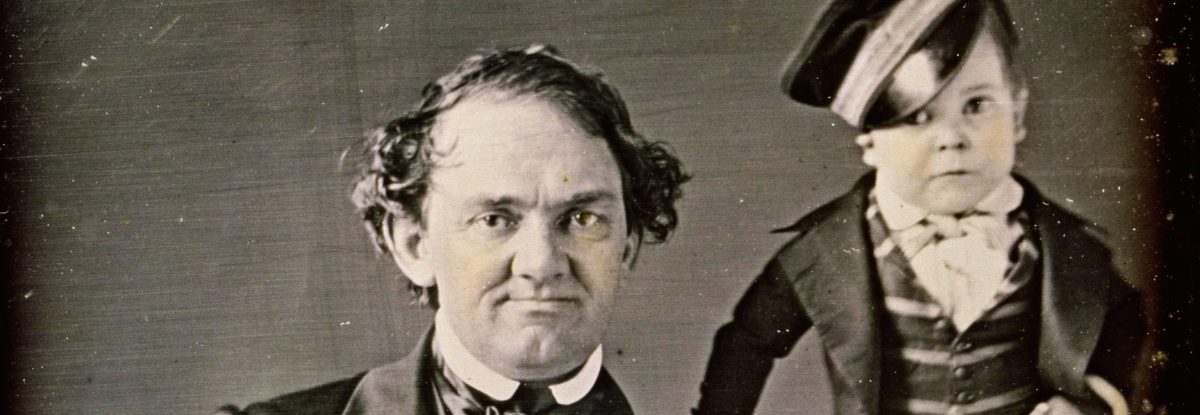He never actually said, “There’s a sucker born every minute,” but P.T. Barnum understood B.S. could be big business. Take the case of Joice Heth. In 1835, Barnum acquired partial “ownership” of an African-American woman who was alleged to be the slave who raised George Washington. There was reason to be wary of this story, since Washington had died in 1799 at age 67. It was insisted that the timeline still made sense, because she was 161. Barnum charged audiences 25 cents to hear her tell tales of Washington’s childhood.
It gets stranger. Heth died in 1836, but Barnum squeezed out one final payday: 1,500 people paid 50 cents each to watch her autopsy. It revealed she was likely about 80, not 160. Refusing to let facts get in the way of a great story, Barnum deepened the deception by leaking to a newspaper that she was in fact still alive.
Born on July 5, 1810, in Bethel, Connecticut, Phineas Taylor Barnum’s name lives on more than 200 years later. (Indeed, he’s the subject of the new Hugh Jackman musical The Greatest Showman.) While we tend to associate Barnum with the circus, he didn’t get involved in those until the 1870s. The bulk of his career was built around P.T. Barnum’s American Museum, which existed from 1841 to 1865. Located at Broadway and Ann in Lower Manhattan, it was in some ways a standard museum, with taxidermied creatures (albeit sometimes of organisms that didn’t actually exist—more on this shortly) and artifacts from the American Revolution.
It also featured living exhibits, such as a wide array of animals. Indeed, when a fire destroyed it in 1865, two whales were reportedly boiled alive. (An attempt to reopen the museum was aborted when it burned again in 1868.)
But the greatest attractions were the “human curiosities.” These individuals were displayed at the American Museum, on tours, and as circus sideshows.
While they were essential to Barnum’s fame, today they are largely forgotten. Here are some of Barnum’s leading attractions, ranging from the oddly inspiring to the horrifyingly exploitive:
General Tom Thumb: Discovered by Barnum at age four, Charles Stratton performed for 40 years until his death in 1883 at 45. At his tallest, he stood roughly three feet. He was a genuine showman: singing, dancing, and performing impressions. His fans included Abraham Lincoln (who quipped that when he stood by Stratton, the people had “the short and the long of it”) and Queen Victoria. Stratton made a considerable amount of money, building a mansion specially designed to suit his proportions. (There is debate about whether he actually lived there.) Stratton was even known to partner up with Barnum and provided him financial assistance in 1856 after Barnum’s bankruptcy.
Chang & Eng: Born in what’s now Thailand, the conjoined twins (called Siamese twins due to their birthplace) earned enough as a sideshow attraction that they were able to buy a plantation in North Carolina and had 22 children between them. The Civil War wiped out their fortune, however, with the result later in life they agreed to a tour of Europe for Barnum. They died in 1874 at age 62, with Chang passing first and Eng following a few hours later.
The Bearded Lady (a.k.a. The Infant Esau): Annie Jones literally grew up in Barnum’s world. Born in Virginia in 1865, her facial hair attracted such interest that she was placed on display in Barnum’s Museum when she was barely a year old. She would come to be celebrated as the “top-selling bearded lady in the country” and developed into a respected musician. Before her death in 1902, she was known for her efforts to stop the usage of the word “freak.”
FeeJee Mermaid. Not all of Barnum’s stars were human or alive or even real. This “mermaid” skeleton combined the head and torso of a monkey combined with the body of a fish.
The Swedish Nightingale. Occasionally Barnum’s promotional gift took a turn for the highbrow. A celebrated opera singer in Europe, Jenny Lind was essentially unknown in the United States. Yet Barnum was intrigued enough by descriptions of her touring success that he launched a media blitz for her stateside, with the result the 29-year-old Swede arrived in New York in 1850 to a frenzy of anticipation. She lived up to the hype, only growing in popularity. The Swedish Nightingale generated a fortune for her favorite charities and, together with Barnum’s marketing efforts, created a general surge in American interest in opera. She proved Barnum’s assertion: “Advertising is to a genuine article what manure is to land—it largely increases the product.”
Prince Randian the Human Caterpillar. Born without arms or legs in South America, Prince Randian arrived in the United States at age 18 in 1889. He spoke four languages, married, started a family, and generally had a successful career until his death at 63 in 1934. Here he displays his impressive self-sufficiency, lighting a cigarette in the 1932 cult classic Freaks.
The Living Skeleton. This one is pretty disturbing. Born in 1841, Isaac Sprague suffered baffling weight loss as a child. It wasn’t until 1865, however, that he decided to make some money off it. (In large part because he was so weakened he couldn’t handle other labor—at times Sprague struggled to find the energy even to stand up.) Sprague’s condition was never diagnosed, but it caused him to weigh less than 50 pounds throughout his adulthood despite his efforts to eat constantly. Sprague married and was proud to have three sons he described as “well developed, large and strong and to my unspeakable happiness, showing no signs of the malady which distinguishes me.” Sprague died in 1887 at the age of 45. He is credited with creating a wave of other “Living Skeletons” as Americans flocked to see people who were dangerously thin.
“Zip the What Is It?” Be warned: this one’s incredibly disturbing. One of six children born to former slaves in New Jersey, William Henry Johnson had an unusually small head and was likely developmentally challenged. (Leading to his other nickname: Zip the Pinhead.) Barnum came to promote him as a sort of “missing link” from Africa. He had Zip wear a monkey suit (minus mask) and either remain completely silent or speak gibberish. The only thing that can be said in defense of the act was that it earned Johnson a solid living for decades. (Indeed, the Civil War photographer Matthew Brady photographed Zip and deemed him the “Dean of the Freaks.”) Johnson died in 1926, with his death certificate indicating he was 83 years old. Allegedly his dying words were, “Well, we fooled ’em for a long time.”
The Greatest Showman, which earned Golden Globe nominations for Best Musical or Comedy and Best Actor for Jackman, features Joice Heth, Tom Thumb, Jenny Lind, and “Lettie Lutz,” who seems a bit like Annie Jones (in the sense they’re both bearded ladies). You can watch the movie’s “live” TV commercial musical number below, which is the sort of audacious publicity stunt old P.T. would have loved.
This article was featured in the InsideHook newsletter. Sign up now.
























